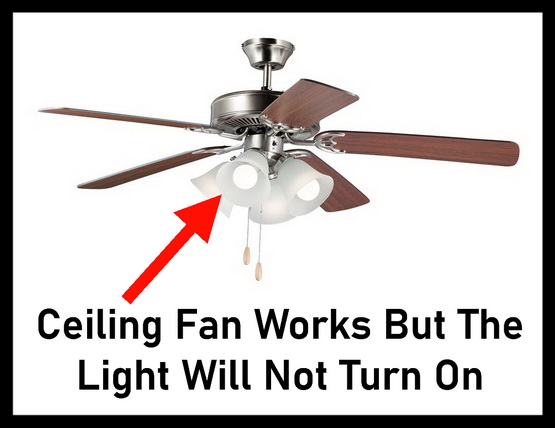When a ceiling fan rotates normally but its light fails to turn on, it could be a bad bulb. This problem can still happen even after the light bulb has been replaced or the pull chain and wall switch have been checked.
 Ceiling fan works but light does not
Ceiling fan works but light does not
Finding out why a ceiling fan light does not work involves checking components of the fan. The ceiling fan and the light have separate controls, which explains why one can function while the other does not.
| Common Causes Of Fan Light Issue | Ceiling Fan Solutions |
|---|---|
| Burnt Out Bulbs | Replace the bulbs. |
| Loose Wiring Connections | Secure the wiring connections. |
| Faulty Light Switch | Replace or repair the switch. |
| Malfunctioning Pull Chain | Replace the pull chain mechanism. |
| Defective Light Kit | Inspect and possibly replace the light kit. |
| Damaged Socket or Wiring in the Light Kit | Inspect and repair/replace the socket or wiring. |
Fix It Fast: Replacing Bulbs: Simply install new bulbs, ensuring they match the specifications for your ceiling fan. Securing Wiring Connections: Tighten any loose connections and replace worn-out wires as needed. Use wire connectors or electrical tape for a secure fit. Replacing the Switch: Acquire a new switch that matches your old one. Reconnect the wires to the new switch following the same configuration as the old switch. Replacing the Pull Chain Mechanism: Remove the old mechanism and install a new one in the same manner, making sure all connections are secure and properly installed. Replacing the Light Kit: Detach the old light kit from the ceiling fan. Follow the manufacturer’s instructions to install the new kit correctly, ensuring that it is properly connected and secured.
How to fix a ceiling fan light
Get Fan Ready for Repair
Turn off the fan and then disconnect the power supply. This step is typically performed by switching off the circuit breaker that powers the fan. Once the power is safely disconnected, you can access the light fixture. This involves removing the light cover, which might require unscrewing it or twisting it off.
Burnt Out Bulbs
The first and simplest issue to address is burnt out bulbs. Carefully unscrew the bulb from its socket and examine it. If the filament inside the bulb is broken, it means that the bulb needs to be replaced. Remember to choose bulbs that are compatible with your ceiling fan’s specifications. Look on the bulb itself and it will give you the info you need to get the exact same ones.
Loose Wiring Connections
If the light bulbs are in good condition, the next step is to check for loose or disconnected wiring. This is a common cause of malfunction in ceiling fan lights. Inspect each wire carefully, paying attention to those connected to the light socket. Make sure all connections are secure.
Faulty Light Switch
For ceiling fans operated by a wall switch, the problem may be within the switch itself. You can diagnose a faulty switch by temporarily bypassing it and directly connecting the wires. If the light operates normally under this setup, it’s a clear indication that the switch is the issue and needs to be replaced. As always, ensure the power is off before you handle any wiring.
Malfunctioning Pull Chain
In ceiling fans equipped with a pull chain, a common issue could be with the chain mechanism itself. Signs of a malfunction include a chain that doesn’t click or feels loose when pulled. To address this, the housing of the fan where the chain is located needs to be opened, and the chain mechanism should be replaced. It’s important to ensure that all connections are secure after replacing it.
Defective Light Kit
Sometimes the problem is with the entire light kit of the ceiling fan. Inspect the kit for any visible signs of damage or wear. If you determine that the light kit is faulty, it’s usually best to replace the entire kit rather than trying to repair individual components. Make sure to select a replacement light kit that is compatible with your ceiling fan model. The part number of the housing should be identifiable by a part number sticker or it may be etched into the metal.
Relevant External Links
Remember, if you encounter difficulties or have specific questions, you can comment below with a description of your issue, including the model number of your ceiling fan, for more tailored assistance.



Leave a Reply